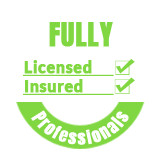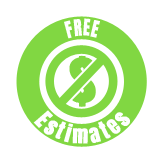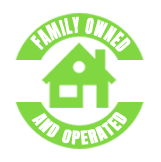This is a question we field often while talking to potential customers. Unfortunately with COVID-19 and all the issues that has brought, one of the big ones is unlicensed, uninsured, and inexperienced people entering job markets as a “business” by renting equipment, putting a door magnet sign on their pickup truck, and declaring themselves a business!
This is bad for you…
Someone claiming “Licensed and Insured!” is often simply putting the words to paper with no actual license or insurance. In fact, most don’t even know what they are actually saying as there is no “license” in the sense of being a licensed electrician for example because there is no oversight in land clearing. A license in our industry refers to a county business tax license. Ask to see it from any company you are thinking about hiring. If they can’t provide a county business tax license, they are not officially operating legally (sunbiz.org is a listing of businesses that registered with the State of Florida, it is not a license to operate in the counties, that would be the County Business Tax license! You see them on the wall of restaurants, stores, etc)
Someone who rents equipment is not dedicated to the business and does not do enough work in the industry to justify owning equipment. This is the first red flag towards identifying an unlicensed business. Sure, sometimes a licensed irrigation company will dabble in land clearing for instance, so it is just the first sign to look for. However, that irrigation company may not have a land clearing rider on their General Liability insurance. Without the rider, their General Liability insurance only covers Irrigation (assuming they have a rider for irrigation and digging!)
Check sunbiz.org and verify their company is listed, by name, as “Active”. If “Inactive” or they do not even show up… that is a huge red flag! You cannot have a bank account or insurance without being registered on sunbiz.org! ShadowCat Services, Inc is listed as “Active” on sunbiz.org. We are also listed as “ShadowCat, LLC” which is how we started, but grew into a S-Corp (Inc).
– Ask them to provide a County Business Tax license. This shows they are formally recognized in the County they are based in. “ShadowCat Services, Inc” is based in, and holds a business license in, Volusia County.
– Finally, outside of typical auto insurance a professional company will hold “General Liability” insurance. Auto Insurance does not cover any damage to you or your property during land clearing, so “General Liability” is needed. Ask to see a copy of their Certificate of Insurance (COI). It should be current. Keep in mind, a company must have specific insurance riders on their General Liability Policy. These riders dictate what general area is covered. Our rider covers land clearing and grading for example. However, an excavation company that offers land clearing on the side may only have an excavation rider. Without the proper riders, the company is not actually insured for any land clearing work!
Being sure to check any company out for these items protects you, but also helps the legitimate small businesses like ShadowCat Services, Inc which are playing by all the rules.
ShadowCat sold our Bushhog attachment as it could not compete with the Forestry Mulcher in efficiency or quality of results. We are happy to explain the differences however so you can decide what you need!
As for the difference, it’s in the name and it’s in the price of the equipment!
Bushhogs:
The average Bushhog attachment cost from $3,000 and top out at around $10,000. A Forestry Mulcher attachment STARTS at over $30,000 for the attachment!!! A set of teeth for the forestry mulcher costs $3000, or almost the same as a Bushhog itself. That is one reason you see many Bushhog operators but few Forestry Mulchers.
Blades on a bushhog cost $40 each and there are only three of them. Teeth on a forestry mulcher cost $90 each and there are thirty teeth! That is the second reason you see many Bushhog operators but few Forestry Mulchers. The replacement teeth alone over the course of a year of operation will cost more than the the purchase price of any bushhog attachment.
A Bushhog primarily is used for tall grass and small bushes. When you see farm tractors on side of the road cutting grass, they are pulling a bushhog. Bushhogs can also be pushed, such as our bushhog picture shown below. However, a bushhog cannot mulch, nor can they handle palmettos or larger brush and trees! Bushhogs are three bladed mowers, similar to a lawn mower so they are limited in performance and quality of results. They can cut down small 1-2 inch diameter trees but you will have large pieces everywhere vs mulch.
Bushhog manufacturers claim to be able to cut through up to 12 inch trees… this is false. Our Diamond bushhog was limited to around five inch diameter trees (cutting, not mulching) and the results are horrible. The Diamond bushhog is one of the largest bushhogs and cost over $14,000… so compare that with people using $4,000 bushhogs and you can expect even poorer results.
Forestry Mulchers:
A Forestry mulcher is used to mulch bushes, small trees, palmetto plants, general overgrowth, etc. Forestry mulchers are great at mulching up to six inch diameter trees. They can go higher, but the reality is that is more marketing by the manufacturer than actual function. Mulching larger trees would simply be a waste of your money. Cutting them down with a chain saw and having them hauled away may be cheaper. It is a simple matter of Scale of Economics… larger trees wear out the teeth of the mulcher much faster, which then requires replacement teeth, which means more cost to the customer to offset operating costs! Stay six inches or below with a mulcher, use a chainsaw above six inches.
While a bushhog cannot handle palmettos, a forestry mulcher slices through palmettos without a problem. Typical Florida overgrowth is no match for a Forestry Mulcher and the pictures in my Before/After galleries are all from Forestry mulching. Pepper trees, palmettos, medium size trees, etc are all Forestry mulcher only type of growth.
A Forestry Mulcher also can only be operated by a large machine with high flow hydraulics. Smaller machines simply do not have the power to lift the attachment or run it at proper speeds.
Below are pictures for comparison.
Bushhog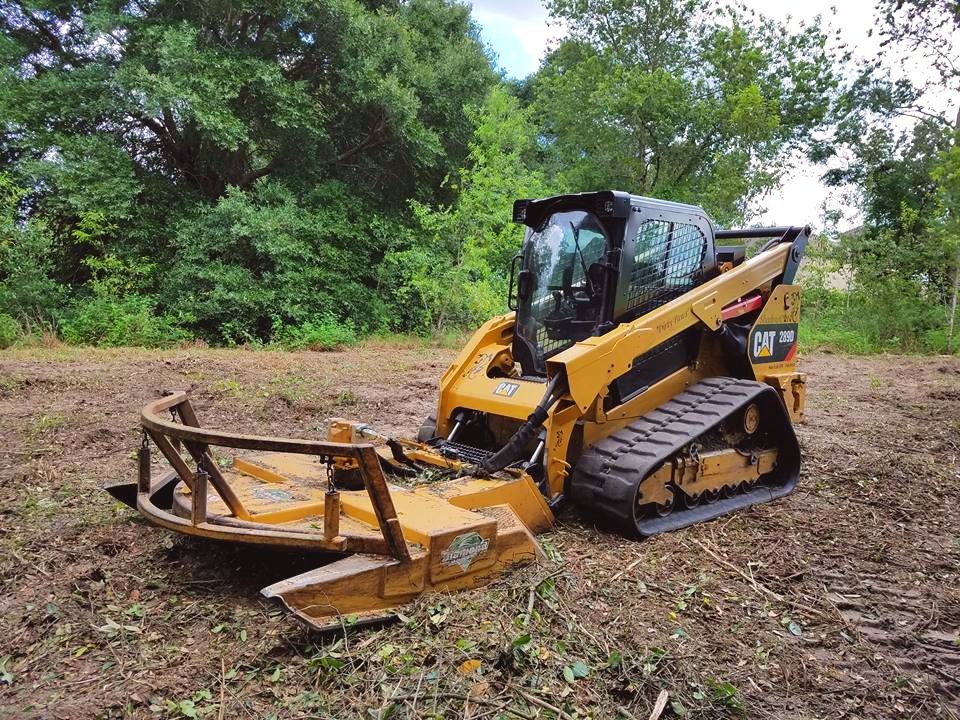
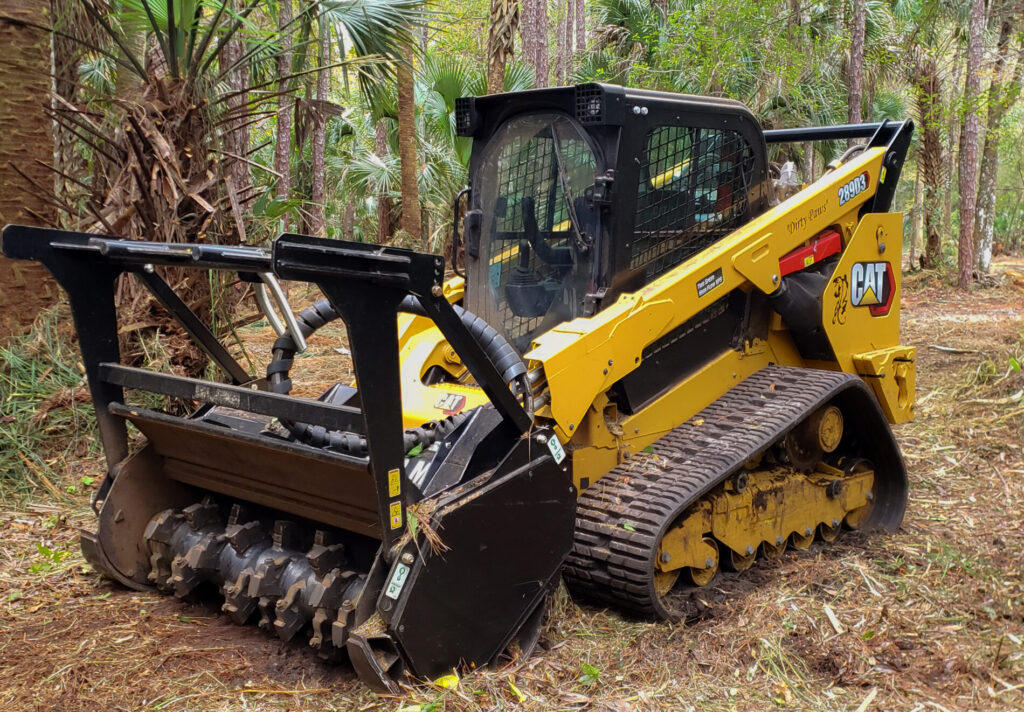
Forestry Mulcher
Results: Bushhog vs Forestry Mulcher:
A Forestry Mulcher vs Bushhog on same thick overgrowth is no match! Below is a picture showing the results of processing the same 6 foot tall scrub oaks and typical Florida overgrowth. The property owner had hired a bushhog operator to clear the land first and was unhappy with the results (left side of picture). He then hired ShadowCat to finish the job and clean up the bushhog’s mess. The right side of the below picture shows the results of a Forestry mulcher clearing same overgrowth. Bushhogs just cut and throw material that is larger than grass or small bushes. Bushhogs are fine for grass and small bushes but cannot handle thicker material as shown which would include sapling trees, palmettos, thick bushes, bamboo, etc
The bushhog operator should never have attempted this job! That is where experience of the operator comes into play. Know the capabilities of the machine and results that can be generated. In our bushhog picture above you can see the light bush and grass in the background I cleared and left the tree line alone even though small trees. The property the forestry mulcher picture is from above can also be seen in the Before and After gallery showing what the property looked like before.
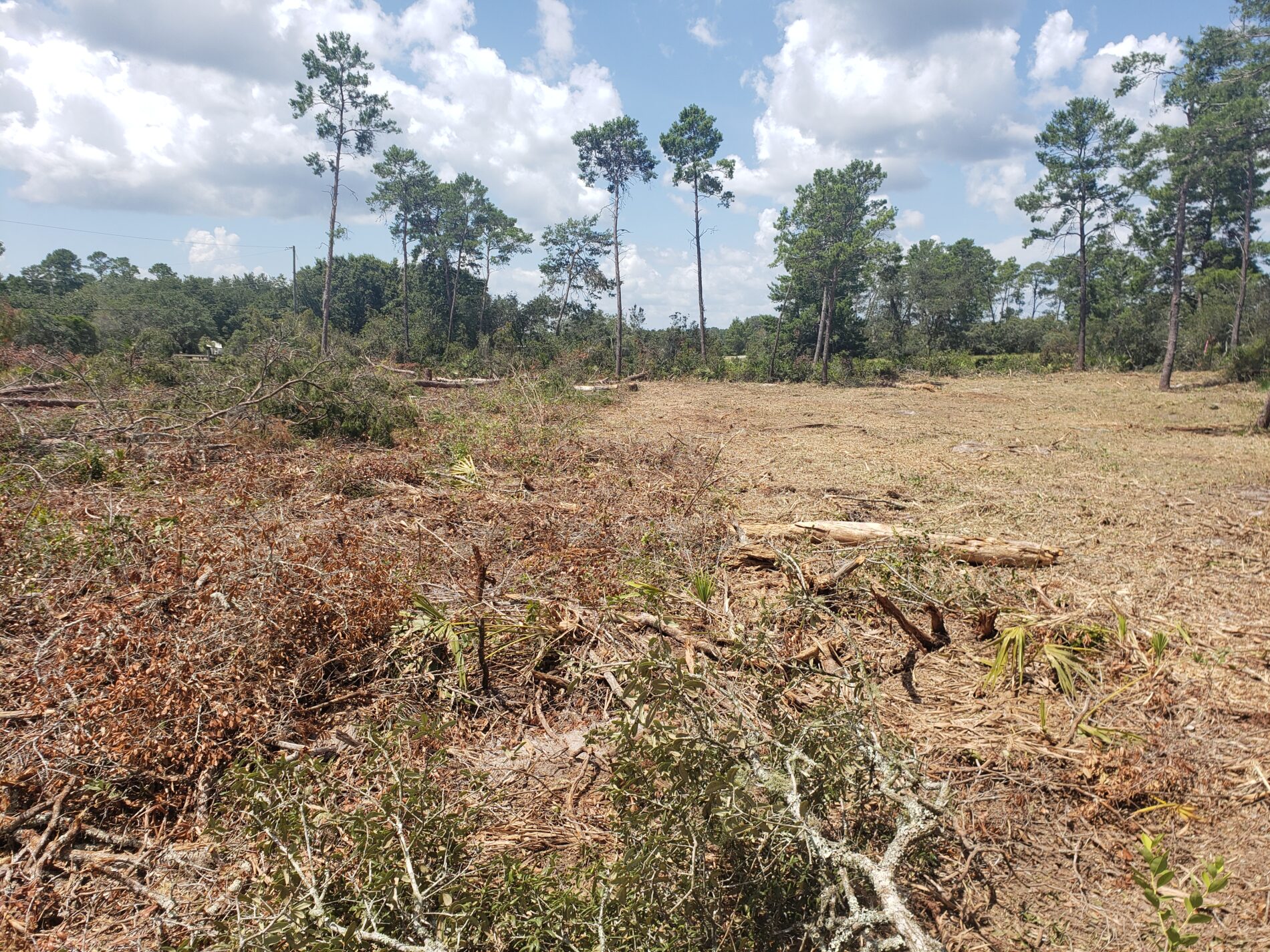
Most counties allow property owners to clear overgrowth without a permit. Depending on the county, overgrowth is generally defined as all brush and small trees up to three or four inches in diameter, measured at four feet height. Palmettos and other invasive species do not require permits in most locations. Always check with your city/county for specifics however as some cities and/or counties are stricter than others! Laws also can change on a yearly basis!
Any large trees will generally require permits to take down unless zoned agriculture. These should be removed by a licensed Tree Service company. ShadowCat can refer you to legitimate Tree Service companies once you are at the point of removing big trees. If you have the permit, or your location does not require a permit and the tree is in a safe location away from power lines and structures, ShadowCat can help you with their removal.
Always verify any business you may use is listed as Active on sunbiz.org and holds a County business license otherwise they are not an official business in the State of Florida and are unlicensed, uninsured, and will just be more trouble than lower cost may provide.
In general, clearing the overgrowth should always be done first! Mainly for four reasons:
Access: Clearing all the overgrowth allows for access across the property.
Safety: Clearing the overgrowth creates a safer environment for you and other contractors who follow ShadowCat at later dates by removing snake habitat as well as potential hazards such as sharp sticks, stumps, etc that could injure people or damage equipment.
Cost: By removing overgrowth, you eliminate the surcharge other companies will add to their service for working in thick overgrowth. They have to account for injuries, snake bites, damage to equipment and such when they cannot see the hazards in the area they are working in, so taking away the overgrowth takes away the extra cost they will charge! A prime example of this is a survey company. If they have to use machetes to cut a path on your property, they will be there for a few days depending on size of the property, vs a few hours if all they have to do is walk across open cleared property to get their survey points.
Site Lines: Are you planning to place a home on the property? Being able to see what the views are from possible window locations matters!
Root Raking: Root raking is the process in which a rake (grapple claw attachment) is stuck approximately six inches into the ground and then driven forward through the dirt to pull up miscellaneous tree and bush roots. Depth can be shallower or deeper as needed depending on what is growing in the area.
Stump Removal: Stump Removal, unlike Stump Grinding, is the total removal of the stump and it’s roots from an area. Stump Grinding can be done by ShadowCat as part of a larger project.
When to do: When to do either of these methods is a personal choice for the most part, but sometimes is dictated by your plans for the property. If you are building a house, metal storage building, or driveway you MUST remove all large roots and stumps in those impacted areas. If a foundation is poured over stumps and large roots, cracks will develop as the organic material decays underneath the cement. Over time, the decaying material will leave voids under the foundation which will lead to severe structural issues later.
If you are planning on running horses on the property, you should completely root rake all areas the horses will run in. Root raking will remove all stumps and large roots that can break a horse’s leg as they are running, so spend the extra time and money to protect your horse!
If the area being cleared will remain more of an open space with no specific use, do your wallet a favor and skip the root raking process! Not many contractors will tell you this as root raking is a money maker in open spaces. Don’t waste money you don’t need to.
Below are pictures of the Root Rake/Grapple Claws attachment.
Rake/Grapple Claws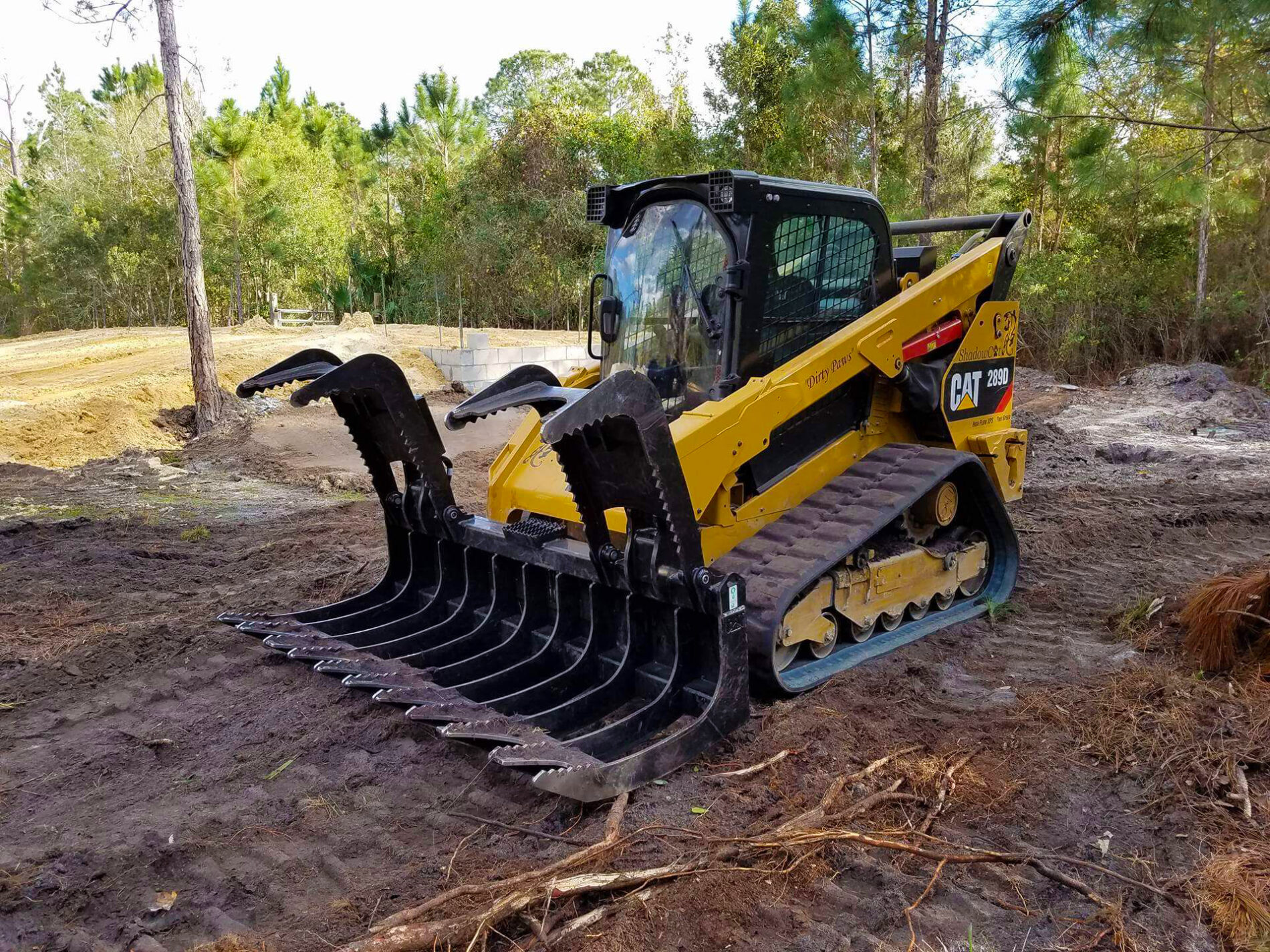
Does ShadowCat hire Sub-Contractors?
No, ShadowCat never hires any sub-contractors! When you work with us, you always deal with the owners! Sherri is the Operations Manager and answers all customer calls and schedules the work. She is also the point of contact for any questions you may have. David does all the field work and works with Sherri to insurance job scope and quotes are correct. Occasionally our son-in-law Blake will do a job, but you are asked prior if that is ok. He is a Lieutenant with the Lake County Fire Department and his First Responder job allows him the schedule to help out if our work load is quite high at any time.
There are some companies out there that do not actually do the work they book! You schedule with them, and a sub-contractor shows up… much like a Fencing Company hires contract crews to do the install. Always ask if the company you are talking to actually will be doing the work. If they are, ask them if the owners are doing the work, or a hired crew.



